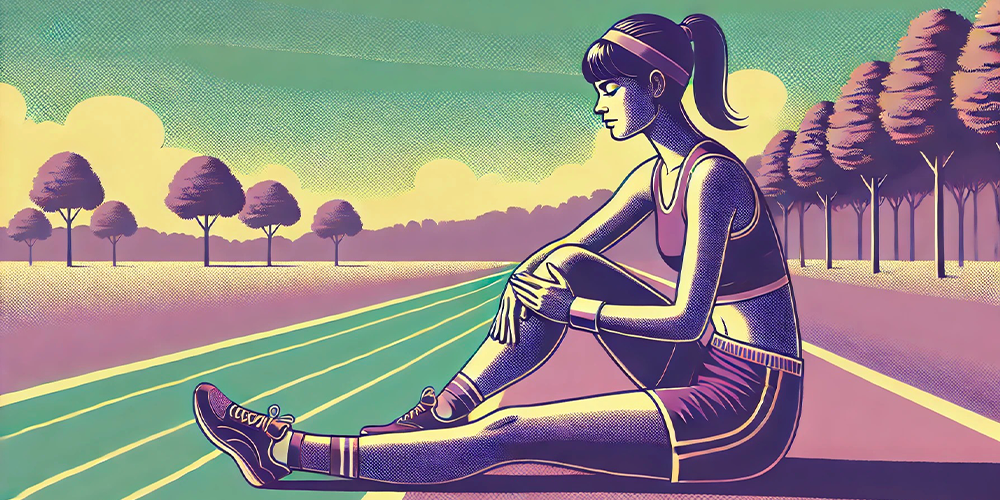Injury is probably the worst issue an athlete has to deal with. Whatever its nature, it brings a season, a passion (for an amateur), or even a career (for a professional) to a sudden stop. Anticipating and preventing injuries is therefore a major goal for any athlete. Let’s explore the key aspects in this blog article.
Article published in TrimaX-magazine January-February 203
By J.B Wiroth, PhD in Sports Science and Founder of the WTS coaching network (www.wts.fr)
This article is provided by Trimax Magazine, one of the leading triathlon magazines. Each month, discover free articles, athlete features, race advice, gear tips and more covering triathlon, cycling, running, duathlon, and swimrun. Click here to learn more.
Origin of an Injury
Anticipation is not a natural reflex in humans. And yet, it helps avoid a great many problems! When it comes to sports injuries, it’s important not to confuse accidental injury with overuse injury. The first occurs suddenly—whether during a sports session or in another context (workplace, at home, etc.). The second develops gradually as a result of training overload.
Whatever the cause, an injury never happens by chance. It is always the result of a state of stress. The injury then forces a break or reduction in training, allowing the body to return to a state of homeostasis. You should see injury as a regulatory mechanism—it forces the athlete to rest, both physically and mentally.
Types of Injuries
1. Tendon injuries (tendinopathies)
Among athletes, the most common injuries are tendon or musculo-tendinous injuries. Tendons play a fundamental role in movement: without them, no joint movement is possible. The tendon is one of the key components in athletic movement. And like any crucial part, it is subject to significant mechanical stress. It can start to malfunction when the stress becomes too high or too sudden.
Tendinopathies primarily appear when the training load is inappropriate or excessive. The tendon becomes inflamed, which forces a reduction in training intensity.
Tendinopathies can be triggered or worsened by:
- Unsuitable or poorly adjusted equipment
- Psychological stress
- Dehydration
- An overly acidic and/or pro-inflammatory diet
The most common tendinopathies among triathletes include:
- Shoulder tendinitis, often occurring during swimming
- Patellar tendinitis, affecting the distal end of the quadriceps (just below the kneecap), commonly from cycling
- Iliotibial band syndrome (ITBS), affecting the distal end of the tensor fasciae latae (TFL) on the outer side of the knee, mainly during running
- Achilles tendinitis, located at the Achilles tendon, also common in running
Thus, it’s clear that the knee is a particularly vulnerable joint for endurance athletes, since it’s engaged in all three sports.
2. Muscle injuries
Muscle injuries are characterized by a partial or complete rupture of muscle fibers. Their causes are quite similar to those of tendinopathies: excessive training, lack of gradual progression, or inadequate equipment.
However, these injuries almost always occur during a maximum power movement for which the muscle is not prepared. The classic example: a friendly soccer match even though you haven’t kicked a ball in ten years. The result can be immediate, even if you’re an excellent triathlete!
Muscle injuries generally occur in three stages:
- Contracture: a persistent muscle spasm
- Tear: partial rupture of muscle fibers
- Strain (rupture): complete tearing of the fibers
3. Bone injuries
Bone injuries are most often linked to impact — usually from a fall while cycling or running.
However, two special cases exist:
- Periostitis: an acute inflammation of the outer layer of bone (the periosteum). Runners’ and triathletes’ tibias are particularly sensitive to this.
- Avulsion fracture: where a tendon or ligament pulls off a fragment of bone at the insertion point.
Both of these are usually caused by excessive training stress.
How to prevent and avoid injury?
The off-season is the ideal time to take stock of your strengths… and especially your weaknesses.
If you’re a “fragile” triathlete, frequently prone to injury, or if you feel “at risk” as soon as your training load increases, then use this quieter period to undergo a complete medical check-up. Visit your sports doctor, physiotherapist, osteopath, or another specialist to evaluate your overall health and strengthen your foundation.
In practical terms, 80% of injuries can be prevented by focusing on the following points:
1. Warm-up
A warm-up is essential before EVERY session, especially in cold weather (which is a risk factor for tendinopathies). For a muscle-tendon structure to function optimally, your core temperature must significantly increase.
- Swimming: start your session with 5 to 10 minutes of joint mobility exercises, then do some dryland muscle activations (squats, lunges, push-ups, dips…)
- Cycling: always start in an easy gear and spin at a cadence over 90 rpm for 15 minutes to gradually warm up your joints. Avoid pushing hard, and instead prioritize cadence (above 70 rpm uphill, above 90 rpm on flat terrain).
- Running: begin with 5–10 minutes of joint mobility. Then, try to reduce the impact of your stride by rolling your foot and, if possible, landing slightly on the forefoot.
2. Hydration and nutrition
Tendons are fibrous structures that are especially sensitive to your hydration status. That’s why it’s essential to hydrate regularly, in small amounts, throughout the day to help prevent tendinitis. The amount of water needed depends on your activity and the temperature, but it generally ranges between 1.5 and 3 liters. One simple rule: your urine should stay clear from morning to night.
If you’re prone to tendinitis, try to reduce acidifying foods such as:
- alcohol
- coffee or black tea
- red meat
- cheese and cow’s milk products
- sodas and sugary snacks
On the other hand, increase your intake of alkaline foods, primarily:
- fresh fruits and vegetables
- healthy fats rich in omega-3s: mackerel, sardines, salmon, rapeseed and walnut oils
3. Oral hygiene
Poor dental health — cavities or other infections — can be a silent source of inflammation for your body. That’s why an annual dental check-up is essential for any athlete.
Brushing your teeth three times a day is very effective. Also, try to limit sugary sports drinks: there’s no need to consume them at every workout. Save them for long or very intense sessions. Your teeth will thank you for it.
4. Equipment
In triathlon, equipment can have a major impact on the appearance of technopathies (i.e., pathologies directly caused by gear or setup).
In swimming, be cautious with paddles: take the time to warm up properly and gradually increase paddle size and usage duration… especially if you’re a beginner swimmer.
On the bike, pay close attention to your positioning. Ideally, consult a bike fitting specialist. A bike fit is strongly recommended at the beginning of each season—or at least every time you change your bike.
While running, take the time to choose your running shoes carefully with the help of a specialist. Test your shoes, and if they don’t feel right, don’t hesitate to switch brands or models. If you’re prone to injuries, use multiple pairs and rotate them between sessions.
5. Posture
When there is a postural imbalance, muscle chains are placed under uneven tension. Over time, training with this imbalance can lead to overuse and eventually trigger tendinous injuries.
The “entry point” can vary: an old, prominent scar; asymmetry in the eyes or jaw; or issues with foot alignment.
To address these imbalances properly, consult a posturologist and begin a targeted correction plan for your posture.
6. Training
General physical preparation (GPP) is now widely endorsed by strength and conditioning coaches. It should be practiced year-round, with varying intensity depending on the training phase.
Some practical examples:
- Strengthening your core (planks and variations) brings significant benefits across all three sports, especially for preventing back pain.
- In swimming: focus on strengthening the external rotators of the shoulder (infraspinatus and teres minor) using resistance bands. Your shoulders will thank you!
- In running: train your legs for strength and balance to improve stability (stability training).
Beyond the three sports, incorporating one or two weekly Pilates or yoga sessions is a great way to prevent injuries. These disciplines help you work on core strength, flexibility, balance, and breathing—all areas that many triathletes tend to neglect, yet are crucial.
How to treat an injury?
Whether it’s tendinous, muscular, or bone-related, the onset of an injury generally requires a reduction in training load.
Step one: Stop any activity that causes pain. Your body is well-designed: acute pain is the best signal that something is wrong. You can continue training at a reduced intensity—as long as it’s pain-free. But above all, NEVER train through pain!
Step two: Applying cold can help relieve pain and the associated inflammation.
Step three: Consult medical professionals, in the following order:
- Your sports doctor, for a thorough clinical exam and an accurate diagnosis
- Undergo any additional exams if your doctor deems them necessary (X-ray, ultrasound, MRI…)
- See your osteopath if needed. After a hard fall on the bike or while running, a “realignment” session with your osteopath is often very helpful
- Undergo physiotherapy sessions, if prescribed
Be careful with self-medication! Painkillers or anti-inflammatories can mask the pain without solving the root issue. They should always be taken under medical supervision.

